Accounting: Recording and Reporting Business Transactions Analysis
VerifiedAdded on 2023/01/03
|13
|2100
|54
Report
AI Summary
This report provides a detailed analysis of recording and reporting business transactions. It begins by identifying decision-makers in organizations and their requirements for accounting information, discussing the advantages and disadvantages of accounting practices. The report then presents practical examples, including journal entries for David and a general ledger and trial balance for Pearce & Sons. Finally, it addresses the impact of the COVID-19 pandemic on income statements, considering factors such as reduced productivity and profitability, and the need for economic resilience. The report covers various aspects of accounting, from fundamental principles to practical applications, making it a comprehensive resource for understanding financial transactions and their implications.
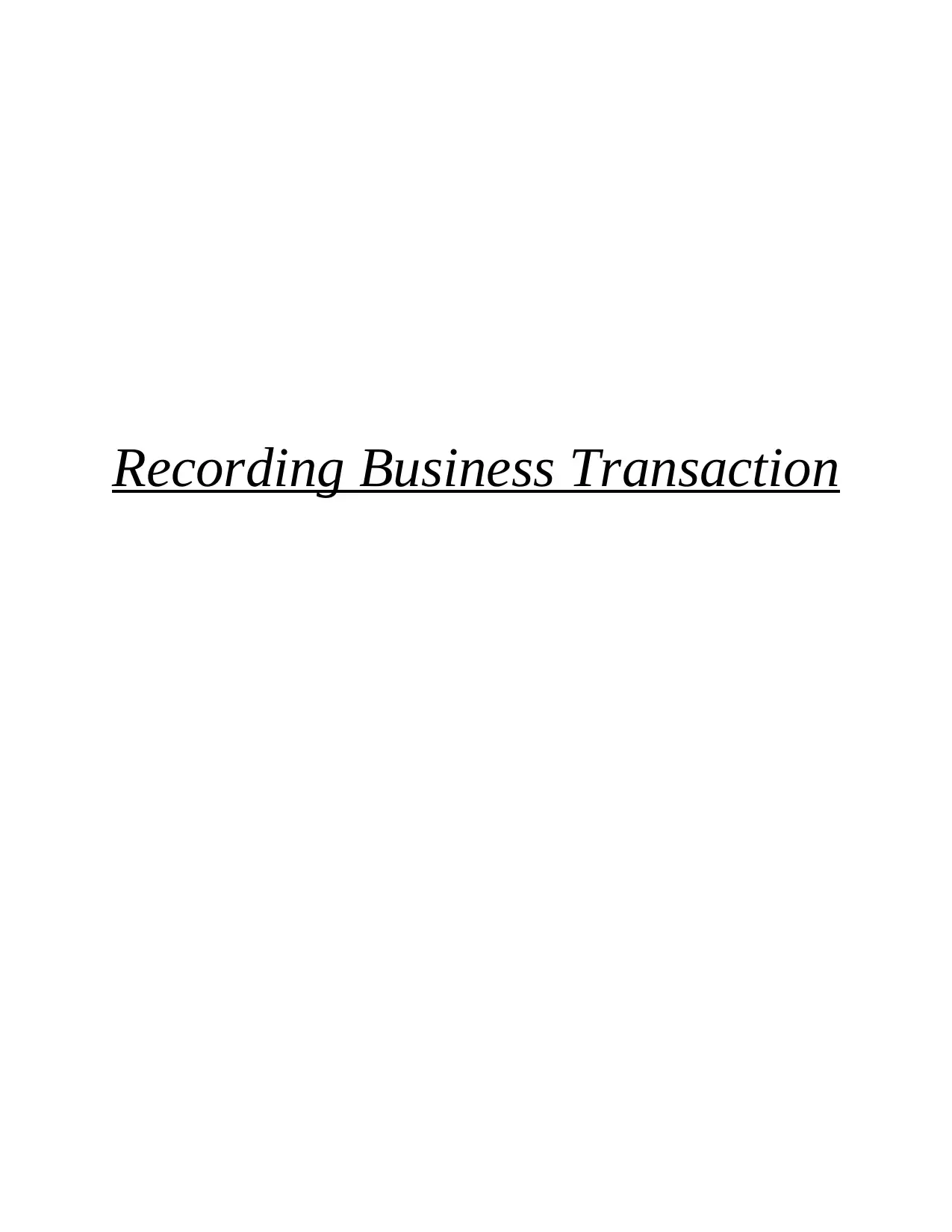
Recording Business Transaction
Paraphrase This Document
Need a fresh take? Get an instant paraphrase of this document with our AI Paraphraser
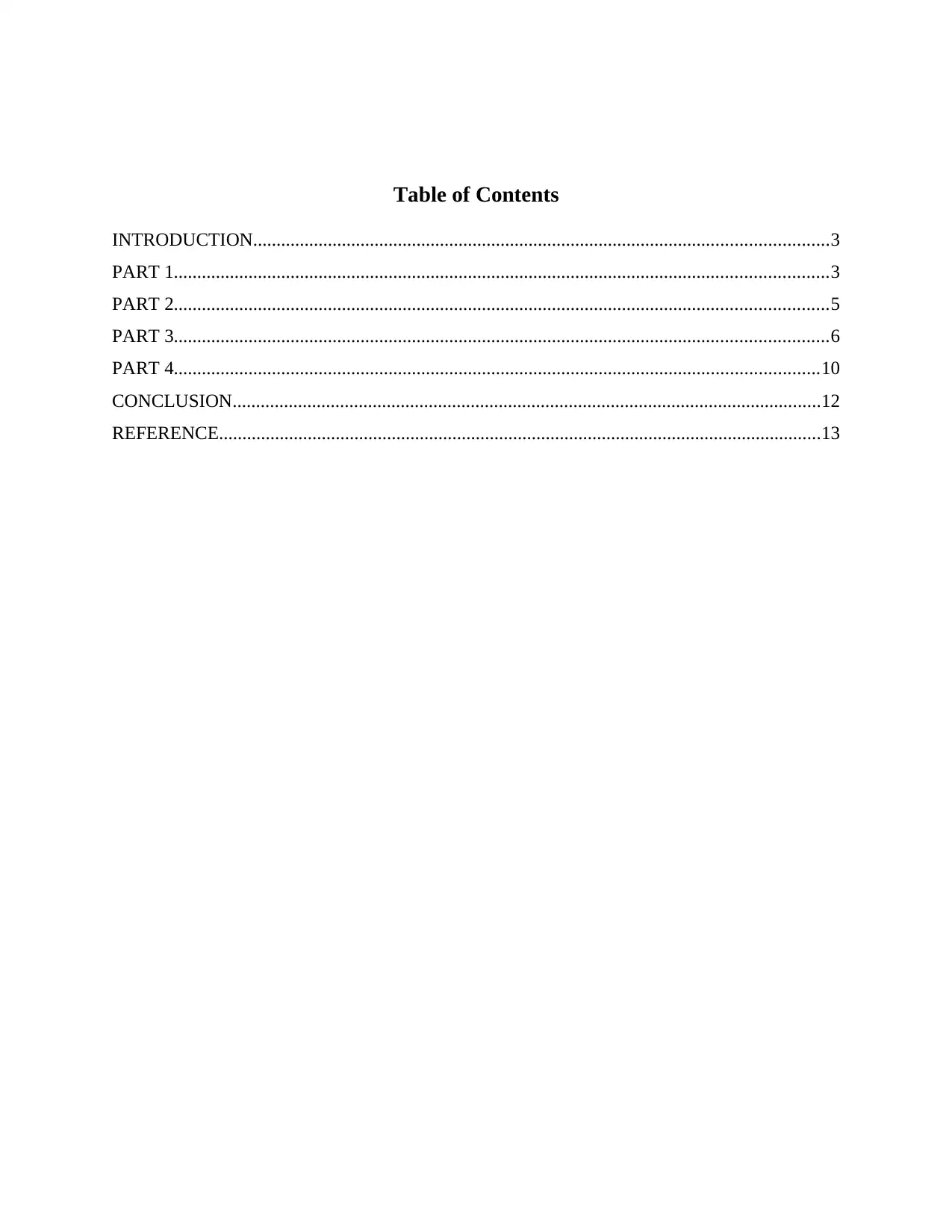
Table of Contents
INTRODUCTION...........................................................................................................................3
PART 1............................................................................................................................................3
PART 2............................................................................................................................................5
PART 3............................................................................................................................................6
PART 4..........................................................................................................................................10
CONCLUSION..............................................................................................................................12
REFERENCE.................................................................................................................................13
INTRODUCTION...........................................................................................................................3
PART 1............................................................................................................................................3
PART 2............................................................................................................................................5
PART 3............................................................................................................................................6
PART 4..........................................................................................................................................10
CONCLUSION..............................................................................................................................12
REFERENCE.................................................................................................................................13
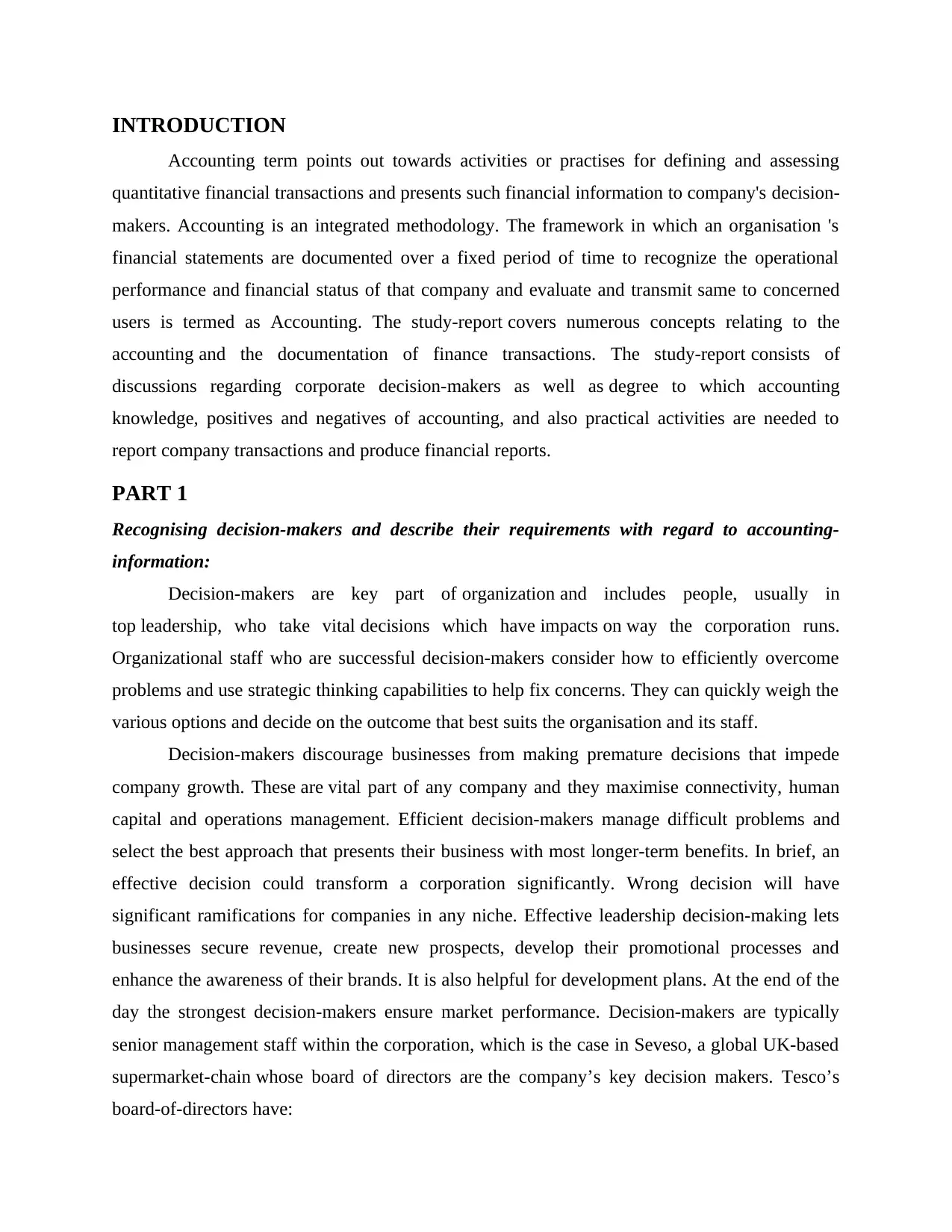
INTRODUCTION
Accounting term points out towards activities or practises for defining and assessing
quantitative financial transactions and presents such financial information to company's decision-
makers. Accounting is an integrated methodology. The framework in which an organisation 's
financial statements are documented over a fixed period of time to recognize the operational
performance and financial status of that company and evaluate and transmit same to concerned
users is termed as Accounting. The study-report covers numerous concepts relating to the
accounting and the documentation of finance transactions. The study-report consists of
discussions regarding corporate decision-makers as well as degree to which accounting
knowledge, positives and negatives of accounting, and also practical activities are needed to
report company transactions and produce financial reports.
PART 1
Recognising decision-makers and describe their requirements with regard to accounting-
information:
Decision-makers are key part of organization and includes people, usually in
top leadership, who take vital decisions which have impacts on way the corporation runs.
Organizational staff who are successful decision-makers consider how to efficiently overcome
problems and use strategic thinking capabilities to help fix concerns. They can quickly weigh the
various options and decide on the outcome that best suits the organisation and its staff.
Decision-makers discourage businesses from making premature decisions that impede
company growth. These are vital part of any company and they maximise connectivity, human
capital and operations management. Efficient decision-makers manage difficult problems and
select the best approach that presents their business with most longer-term benefits. In brief, an
effective decision could transform a corporation significantly. Wrong decision will have
significant ramifications for companies in any niche. Effective leadership decision-making lets
businesses secure revenue, create new prospects, develop their promotional processes and
enhance the awareness of their brands. It is also helpful for development plans. At the end of the
day the strongest decision-makers ensure market performance. Decision-makers are typically
senior management staff within the corporation, which is the case in Seveso, a global UK-based
supermarket-chain whose board of directors are the company’s key decision makers. Tesco’s
board-of-directors have:
Accounting term points out towards activities or practises for defining and assessing
quantitative financial transactions and presents such financial information to company's decision-
makers. Accounting is an integrated methodology. The framework in which an organisation 's
financial statements are documented over a fixed period of time to recognize the operational
performance and financial status of that company and evaluate and transmit same to concerned
users is termed as Accounting. The study-report covers numerous concepts relating to the
accounting and the documentation of finance transactions. The study-report consists of
discussions regarding corporate decision-makers as well as degree to which accounting
knowledge, positives and negatives of accounting, and also practical activities are needed to
report company transactions and produce financial reports.
PART 1
Recognising decision-makers and describe their requirements with regard to accounting-
information:
Decision-makers are key part of organization and includes people, usually in
top leadership, who take vital decisions which have impacts on way the corporation runs.
Organizational staff who are successful decision-makers consider how to efficiently overcome
problems and use strategic thinking capabilities to help fix concerns. They can quickly weigh the
various options and decide on the outcome that best suits the organisation and its staff.
Decision-makers discourage businesses from making premature decisions that impede
company growth. These are vital part of any company and they maximise connectivity, human
capital and operations management. Efficient decision-makers manage difficult problems and
select the best approach that presents their business with most longer-term benefits. In brief, an
effective decision could transform a corporation significantly. Wrong decision will have
significant ramifications for companies in any niche. Effective leadership decision-making lets
businesses secure revenue, create new prospects, develop their promotional processes and
enhance the awareness of their brands. It is also helpful for development plans. At the end of the
day the strongest decision-makers ensure market performance. Decision-makers are typically
senior management staff within the corporation, which is the case in Seveso, a global UK-based
supermarket-chain whose board of directors are the company’s key decision makers. Tesco’s
board-of-directors have:
⊘ This is a preview!⊘
Do you want full access?
Subscribe today to unlock all pages.

Trusted by 1+ million students worldwide
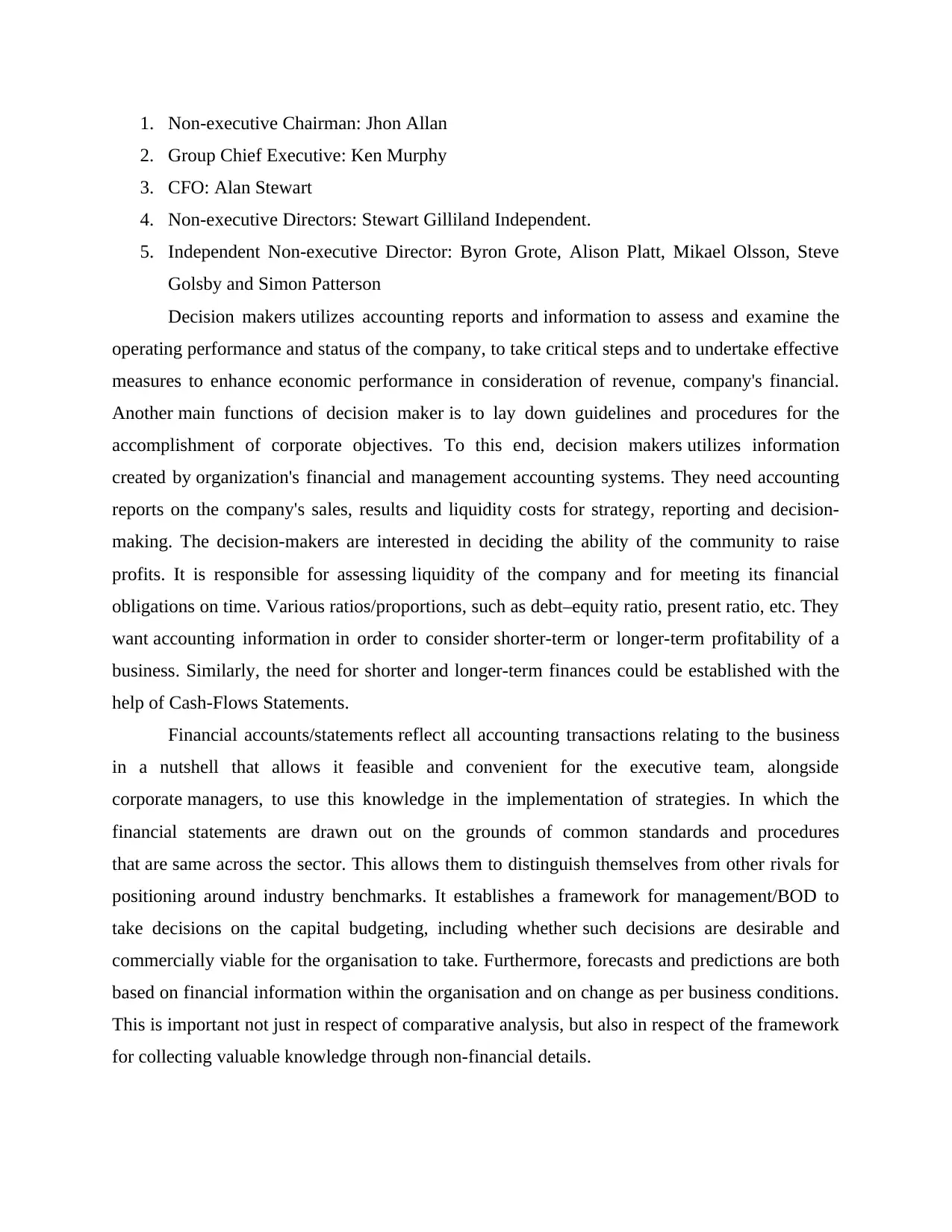
1. Non-executive Chairman: Jhon Allan
2. Group Chief Executive: Ken Murphy
3. CFO: Alan Stewart
4. Non-executive Directors: Stewart Gilliland Independent.
5. Independent Non-executive Director: Byron Grote, Alison Platt, Mikael Olsson, Steve
Golsby and Simon Patterson
Decision makers utilizes accounting reports and information to assess and examine the
operating performance and status of the company, to take critical steps and to undertake effective
measures to enhance economic performance in consideration of revenue, company's financial.
Another main functions of decision maker is to lay down guidelines and procedures for the
accomplishment of corporate objectives. To this end, decision makers utilizes information
created by organization's financial and management accounting systems. They need accounting
reports on the company's sales, results and liquidity costs for strategy, reporting and decision-
making. The decision-makers are interested in deciding the ability of the community to raise
profits. It is responsible for assessing liquidity of the company and for meeting its financial
obligations on time. Various ratios/proportions, such as debt–equity ratio, present ratio, etc. They
want accounting information in order to consider shorter-term or longer-term profitability of a
business. Similarly, the need for shorter and longer-term finances could be established with the
help of Cash-Flows Statements.
Financial accounts/statements reflect all accounting transactions relating to the business
in a nutshell that allows it feasible and convenient for the executive team, alongside
corporate managers, to use this knowledge in the implementation of strategies. In which the
financial statements are drawn out on the grounds of common standards and procedures
that are same across the sector. This allows them to distinguish themselves from other rivals for
positioning around industry benchmarks. It establishes a framework for management/BOD to
take decisions on the capital budgeting, including whether such decisions are desirable and
commercially viable for the organisation to take. Furthermore, forecasts and predictions are both
based on financial information within the organisation and on change as per business conditions.
This is important not just in respect of comparative analysis, but also in respect of the framework
for collecting valuable knowledge through non-financial details.
2. Group Chief Executive: Ken Murphy
3. CFO: Alan Stewart
4. Non-executive Directors: Stewart Gilliland Independent.
5. Independent Non-executive Director: Byron Grote, Alison Platt, Mikael Olsson, Steve
Golsby and Simon Patterson
Decision makers utilizes accounting reports and information to assess and examine the
operating performance and status of the company, to take critical steps and to undertake effective
measures to enhance economic performance in consideration of revenue, company's financial.
Another main functions of decision maker is to lay down guidelines and procedures for the
accomplishment of corporate objectives. To this end, decision makers utilizes information
created by organization's financial and management accounting systems. They need accounting
reports on the company's sales, results and liquidity costs for strategy, reporting and decision-
making. The decision-makers are interested in deciding the ability of the community to raise
profits. It is responsible for assessing liquidity of the company and for meeting its financial
obligations on time. Various ratios/proportions, such as debt–equity ratio, present ratio, etc. They
want accounting information in order to consider shorter-term or longer-term profitability of a
business. Similarly, the need for shorter and longer-term finances could be established with the
help of Cash-Flows Statements.
Financial accounts/statements reflect all accounting transactions relating to the business
in a nutshell that allows it feasible and convenient for the executive team, alongside
corporate managers, to use this knowledge in the implementation of strategies. In which the
financial statements are drawn out on the grounds of common standards and procedures
that are same across the sector. This allows them to distinguish themselves from other rivals for
positioning around industry benchmarks. It establishes a framework for management/BOD to
take decisions on the capital budgeting, including whether such decisions are desirable and
commercially viable for the organisation to take. Furthermore, forecasts and predictions are both
based on financial information within the organisation and on change as per business conditions.
This is important not just in respect of comparative analysis, but also in respect of the framework
for collecting valuable knowledge through non-financial details.
Paraphrase This Document
Need a fresh take? Get an instant paraphrase of this document with our AI Paraphraser
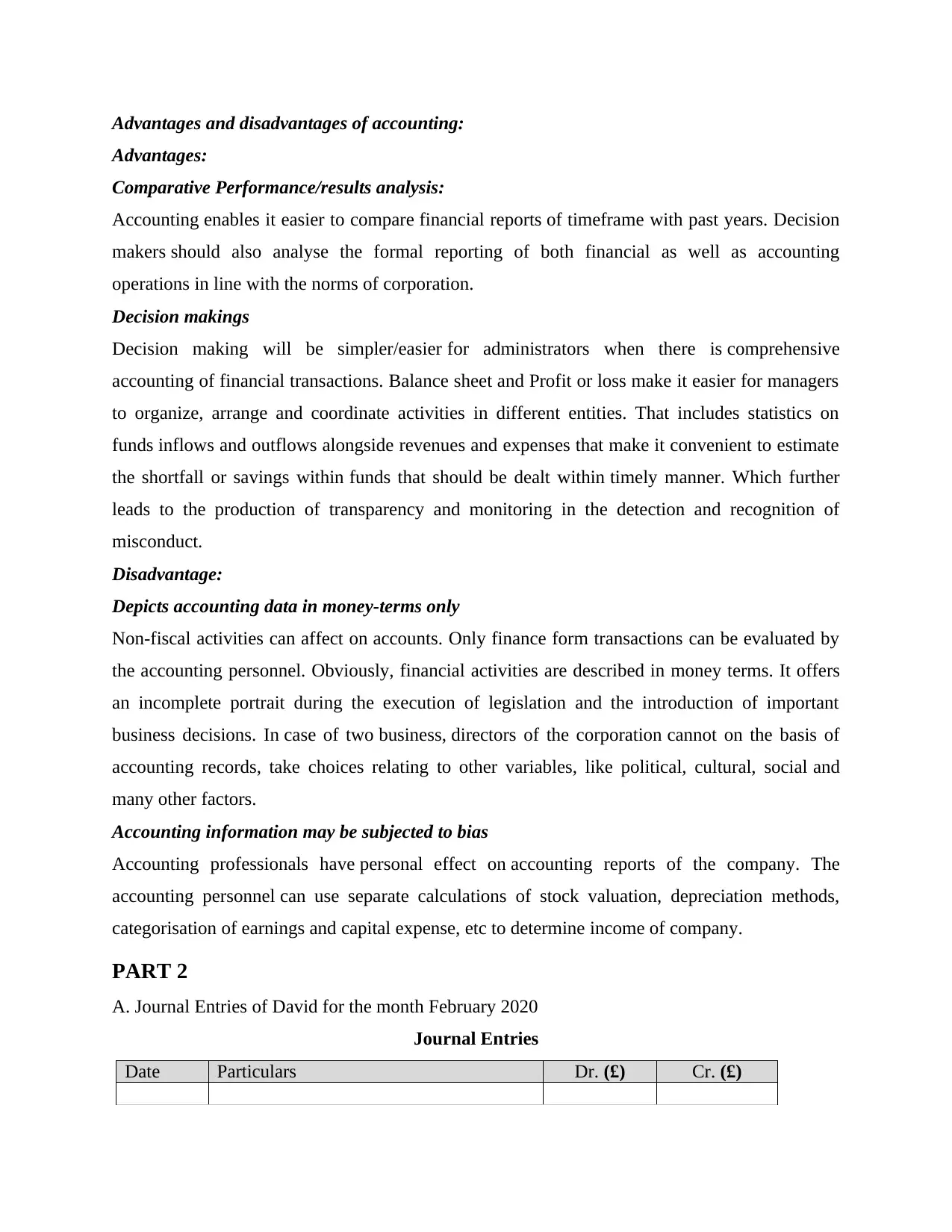
Advantages and disadvantages of accounting:
Advantages:
Comparative Performance/results analysis:
Accounting enables it easier to compare financial reports of timeframe with past years. Decision
makers should also analyse the formal reporting of both financial as well as accounting
operations in line with the norms of corporation.
Decision makings
Decision making will be simpler/easier for administrators when there is comprehensive
accounting of financial transactions. Balance sheet and Profit or loss make it easier for managers
to organize, arrange and coordinate activities in different entities. That includes statistics on
funds inflows and outflows alongside revenues and expenses that make it convenient to estimate
the shortfall or savings within funds that should be dealt within timely manner. Which further
leads to the production of transparency and monitoring in the detection and recognition of
misconduct.
Disadvantage:
Depicts accounting data in money-terms only
Non-fiscal activities can affect on accounts. Only finance form transactions can be evaluated by
the accounting personnel. Obviously, financial activities are described in money terms. It offers
an incomplete portrait during the execution of legislation and the introduction of important
business decisions. In case of two business, directors of the corporation cannot on the basis of
accounting records, take choices relating to other variables, like political, cultural, social and
many other factors.
Accounting information may be subjected to bias
Accounting professionals have personal effect on accounting reports of the company. The
accounting personnel can use separate calculations of stock valuation, depreciation methods,
categorisation of earnings and capital expense, etc to determine income of company.
PART 2
A. Journal Entries of David for the month February 2020
Journal Entries
Date Particulars Dr. (£) Cr. (£)
Advantages:
Comparative Performance/results analysis:
Accounting enables it easier to compare financial reports of timeframe with past years. Decision
makers should also analyse the formal reporting of both financial as well as accounting
operations in line with the norms of corporation.
Decision makings
Decision making will be simpler/easier for administrators when there is comprehensive
accounting of financial transactions. Balance sheet and Profit or loss make it easier for managers
to organize, arrange and coordinate activities in different entities. That includes statistics on
funds inflows and outflows alongside revenues and expenses that make it convenient to estimate
the shortfall or savings within funds that should be dealt within timely manner. Which further
leads to the production of transparency and monitoring in the detection and recognition of
misconduct.
Disadvantage:
Depicts accounting data in money-terms only
Non-fiscal activities can affect on accounts. Only finance form transactions can be evaluated by
the accounting personnel. Obviously, financial activities are described in money terms. It offers
an incomplete portrait during the execution of legislation and the introduction of important
business decisions. In case of two business, directors of the corporation cannot on the basis of
accounting records, take choices relating to other variables, like political, cultural, social and
many other factors.
Accounting information may be subjected to bias
Accounting professionals have personal effect on accounting reports of the company. The
accounting personnel can use separate calculations of stock valuation, depreciation methods,
categorisation of earnings and capital expense, etc to determine income of company.
PART 2
A. Journal Entries of David for the month February 2020
Journal Entries
Date Particulars Dr. (£) Cr. (£)
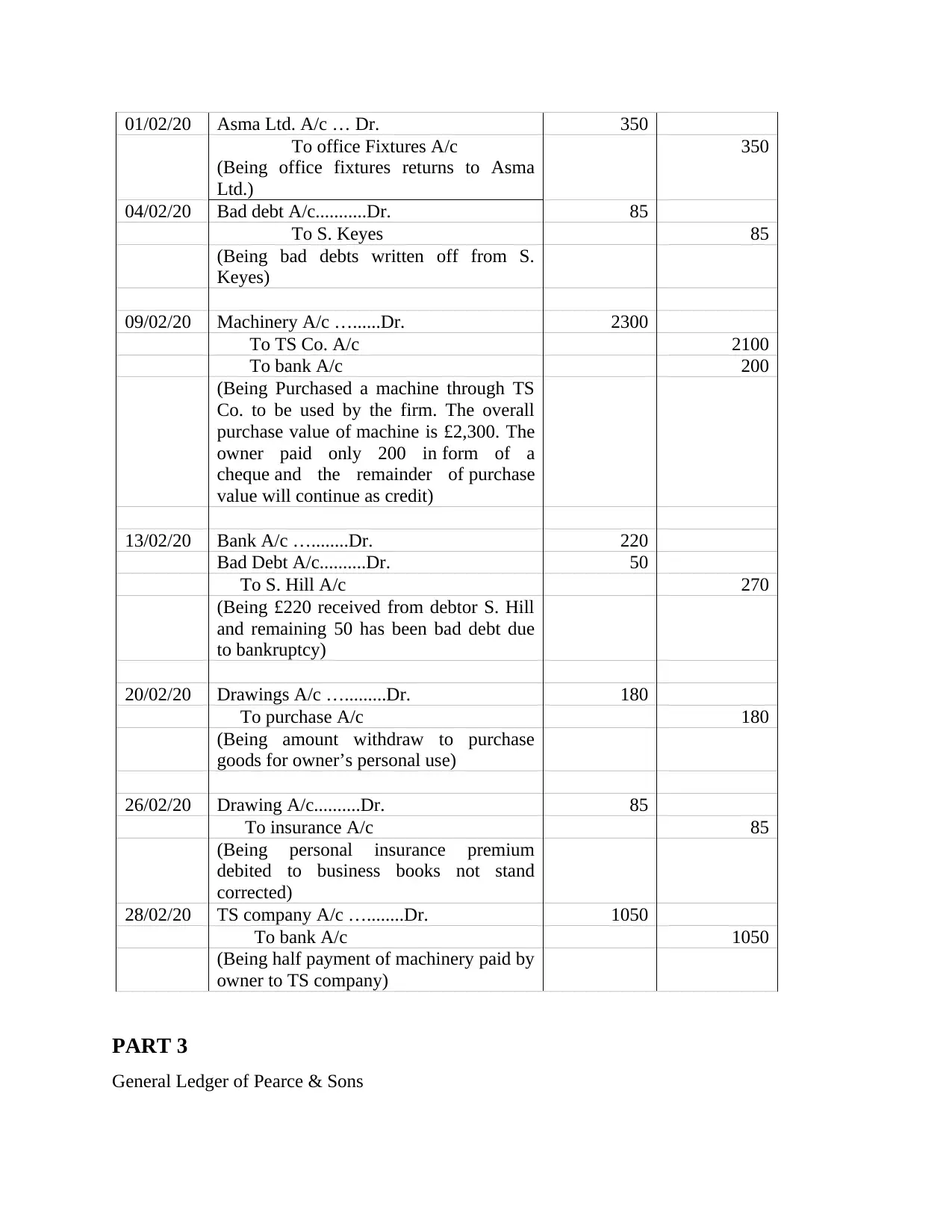
01/02/20 Asma Ltd. A/c … Dr. 350
To office Fixtures A/c
(Being office fixtures returns to Asma
Ltd.)
350
04/02/20 Bad debt A/c...........Dr. 85
To S. Keyes 85
(Being bad debts written off from S.
Keyes)
09/02/20 Machinery A/c …......Dr. 2300
To TS Co. A/c 2100
To bank A/c 200
(Being Purchased a machine through TS
Co. to be used by the firm. The overall
purchase value of machine is £2,300. The
owner paid only 200 in form of a
cheque and the remainder of purchase
value will continue as credit)
13/02/20 Bank A/c …........Dr. 220
Bad Debt A/c..........Dr. 50
To S. Hill A/c 270
(Being £220 received from debtor S. Hill
and remaining 50 has been bad debt due
to bankruptcy)
20/02/20 Drawings A/c ….........Dr. 180
To purchase A/c 180
(Being amount withdraw to purchase
goods for owner’s personal use)
26/02/20 Drawing A/c..........Dr. 85
To insurance A/c 85
(Being personal insurance premium
debited to business books not stand
corrected)
28/02/20 TS company A/c …........Dr. 1050
To bank A/c 1050
(Being half payment of machinery paid by
owner to TS company)
PART 3
General Ledger of Pearce & Sons
To office Fixtures A/c
(Being office fixtures returns to Asma
Ltd.)
350
04/02/20 Bad debt A/c...........Dr. 85
To S. Keyes 85
(Being bad debts written off from S.
Keyes)
09/02/20 Machinery A/c …......Dr. 2300
To TS Co. A/c 2100
To bank A/c 200
(Being Purchased a machine through TS
Co. to be used by the firm. The overall
purchase value of machine is £2,300. The
owner paid only 200 in form of a
cheque and the remainder of purchase
value will continue as credit)
13/02/20 Bank A/c …........Dr. 220
Bad Debt A/c..........Dr. 50
To S. Hill A/c 270
(Being £220 received from debtor S. Hill
and remaining 50 has been bad debt due
to bankruptcy)
20/02/20 Drawings A/c ….........Dr. 180
To purchase A/c 180
(Being amount withdraw to purchase
goods for owner’s personal use)
26/02/20 Drawing A/c..........Dr. 85
To insurance A/c 85
(Being personal insurance premium
debited to business books not stand
corrected)
28/02/20 TS company A/c …........Dr. 1050
To bank A/c 1050
(Being half payment of machinery paid by
owner to TS company)
PART 3
General Ledger of Pearce & Sons
⊘ This is a preview!⊘
Do you want full access?
Subscribe today to unlock all pages.

Trusted by 1+ million students worldwide
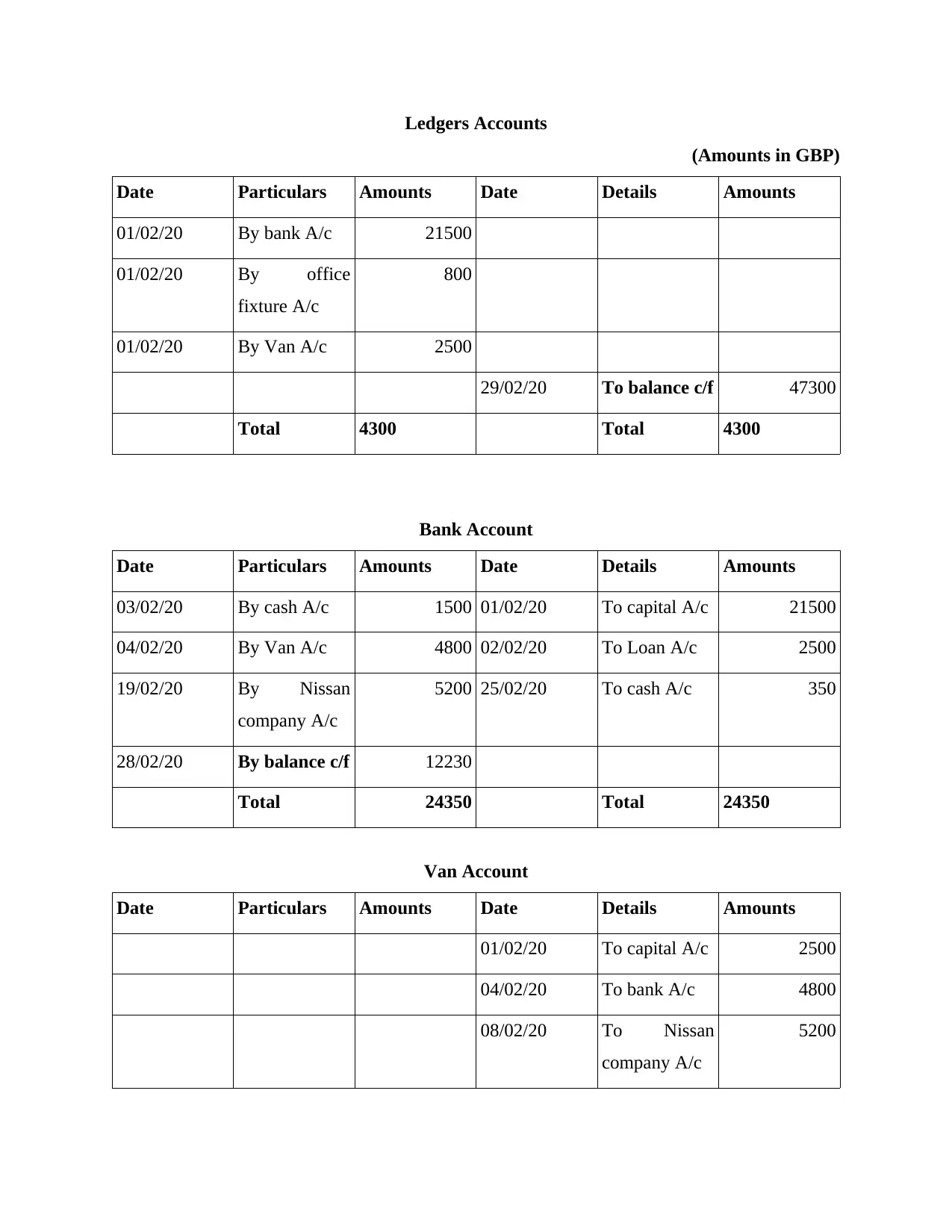
Ledgers Accounts
(Amounts in GBP)
Date Particulars Amounts Date Details Amounts
01/02/20 By bank A/c 21500
01/02/20 By office
fixture A/c
800
01/02/20 By Van A/c 2500
29/02/20 To balance c/f 47300
Total 4300 Total 4300
Bank Account
Date Particulars Amounts Date Details Amounts
03/02/20 By cash A/c 1500 01/02/20 To capital A/c 21500
04/02/20 By Van A/c 4800 02/02/20 To Loan A/c 2500
19/02/20 By Nissan
company A/c
5200 25/02/20 To cash A/c 350
28/02/20 By balance c/f 12230
Total 24350 Total 24350
Van Account
Date Particulars Amounts Date Details Amounts
01/02/20 To capital A/c 2500
04/02/20 To bank A/c 4800
08/02/20 To Nissan
company A/c
5200
(Amounts in GBP)
Date Particulars Amounts Date Details Amounts
01/02/20 By bank A/c 21500
01/02/20 By office
fixture A/c
800
01/02/20 By Van A/c 2500
29/02/20 To balance c/f 47300
Total 4300 Total 4300
Bank Account
Date Particulars Amounts Date Details Amounts
03/02/20 By cash A/c 1500 01/02/20 To capital A/c 21500
04/02/20 By Van A/c 4800 02/02/20 To Loan A/c 2500
19/02/20 By Nissan
company A/c
5200 25/02/20 To cash A/c 350
28/02/20 By balance c/f 12230
Total 24350 Total 24350
Van Account
Date Particulars Amounts Date Details Amounts
01/02/20 To capital A/c 2500
04/02/20 To bank A/c 4800
08/02/20 To Nissan
company A/c
5200
Paraphrase This Document
Need a fresh take? Get an instant paraphrase of this document with our AI Paraphraser
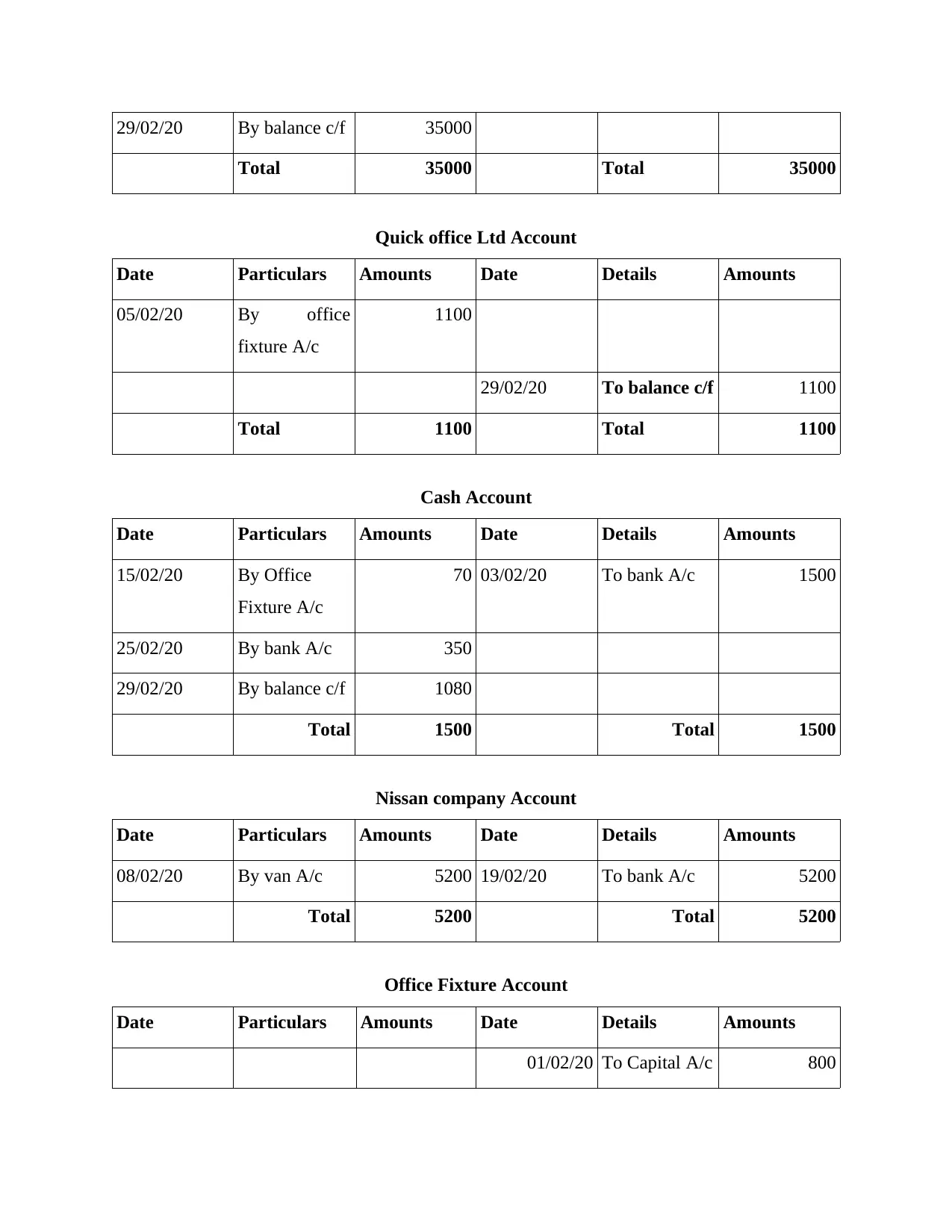
29/02/20 By balance c/f 35000
Total 35000 Total 35000
Quick office Ltd Account
Date Particulars Amounts Date Details Amounts
05/02/20 By office
fixture A/c
1100
29/02/20 To balance c/f 1100
Total 1100 Total 1100
Cash Account
Date Particulars Amounts Date Details Amounts
15/02/20 By Office
Fixture A/c
70 03/02/20 To bank A/c 1500
25/02/20 By bank A/c 350
29/02/20 By balance c/f 1080
Total 1500 Total 1500
Nissan company Account
Date Particulars Amounts Date Details Amounts
08/02/20 By van A/c 5200 19/02/20 To bank A/c 5200
Total 5200 Total 5200
Office Fixture Account
Date Particulars Amounts Date Details Amounts
01/02/20 To Capital A/c 800
Total 35000 Total 35000
Quick office Ltd Account
Date Particulars Amounts Date Details Amounts
05/02/20 By office
fixture A/c
1100
29/02/20 To balance c/f 1100
Total 1100 Total 1100
Cash Account
Date Particulars Amounts Date Details Amounts
15/02/20 By Office
Fixture A/c
70 03/02/20 To bank A/c 1500
25/02/20 By bank A/c 350
29/02/20 By balance c/f 1080
Total 1500 Total 1500
Nissan company Account
Date Particulars Amounts Date Details Amounts
08/02/20 By van A/c 5200 19/02/20 To bank A/c 5200
Total 5200 Total 5200
Office Fixture Account
Date Particulars Amounts Date Details Amounts
01/02/20 To Capital A/c 800
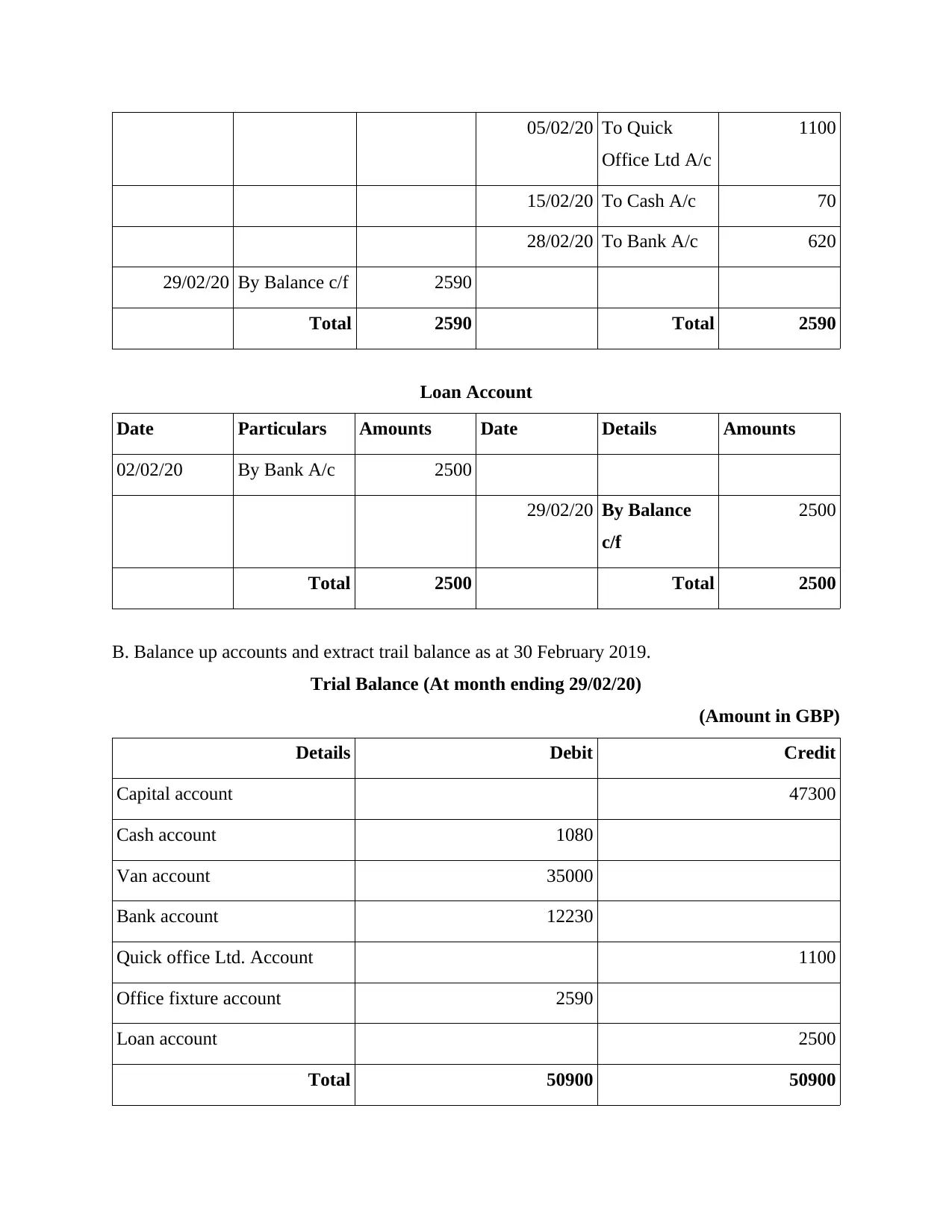
05/02/20 To Quick
Office Ltd A/c
1100
15/02/20 To Cash A/c 70
28/02/20 To Bank A/c 620
29/02/20 By Balance c/f 2590
Total 2590 Total 2590
Loan Account
Date Particulars Amounts Date Details Amounts
02/02/20 By Bank A/c 2500
29/02/20 By Balance
c/f
2500
Total 2500 Total 2500
B. Balance up accounts and extract trail balance as at 30 February 2019.
Trial Balance (At month ending 29/02/20)
(Amount in GBP)
Details Debit Credit
Capital account 47300
Cash account 1080
Van account 35000
Bank account 12230
Quick office Ltd. Account 1100
Office fixture account 2590
Loan account 2500
Total 50900 50900
Office Ltd A/c
1100
15/02/20 To Cash A/c 70
28/02/20 To Bank A/c 620
29/02/20 By Balance c/f 2590
Total 2590 Total 2590
Loan Account
Date Particulars Amounts Date Details Amounts
02/02/20 By Bank A/c 2500
29/02/20 By Balance
c/f
2500
Total 2500 Total 2500
B. Balance up accounts and extract trail balance as at 30 February 2019.
Trial Balance (At month ending 29/02/20)
(Amount in GBP)
Details Debit Credit
Capital account 47300
Cash account 1080
Van account 35000
Bank account 12230
Quick office Ltd. Account 1100
Office fixture account 2590
Loan account 2500
Total 50900 50900
⊘ This is a preview!⊘
Do you want full access?
Subscribe today to unlock all pages.

Trusted by 1+ million students worldwide
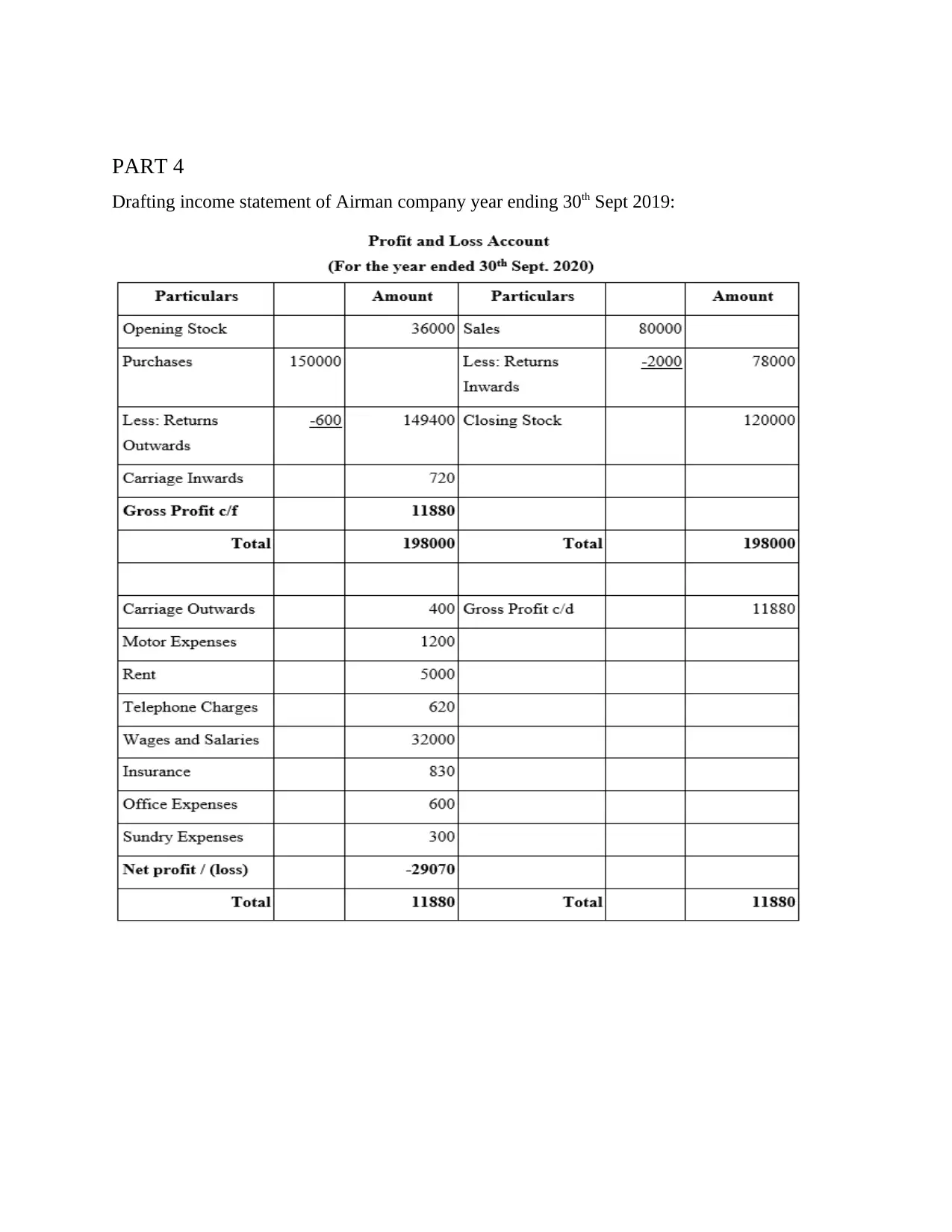
PART 4
Drafting income statement of Airman company year ending 30th Sept 2019:
Drafting income statement of Airman company year ending 30th Sept 2019:
Paraphrase This Document
Need a fresh take? Get an instant paraphrase of this document with our AI Paraphraser
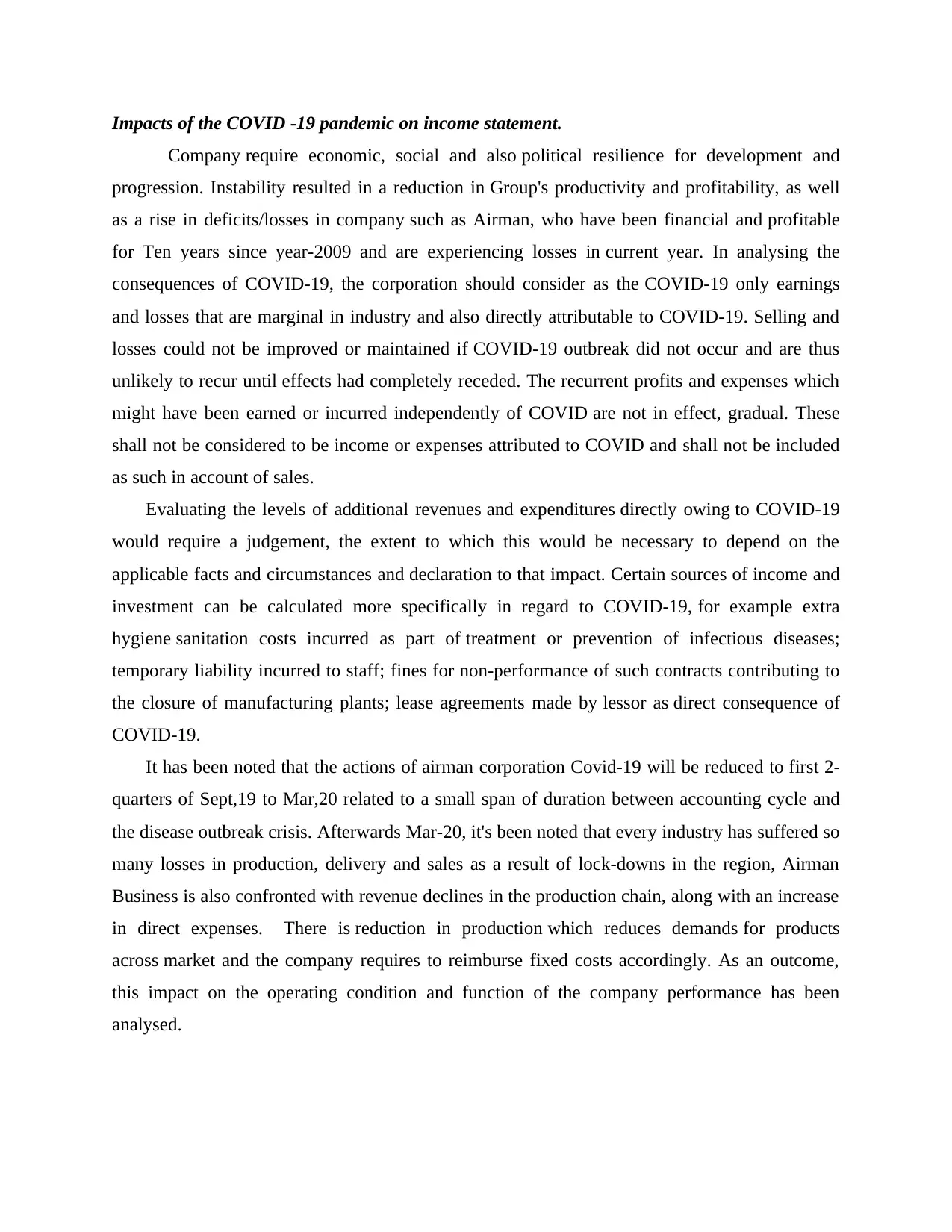
Impacts of the COVID -19 pandemic on income statement.
Company require economic, social and also political resilience for development and
progression. Instability resulted in a reduction in Group's productivity and profitability, as well
as a rise in deficits/losses in company such as Airman, who have been financial and profitable
for Ten years since year-2009 and are experiencing losses in current year. In analysing the
consequences of COVID-19, the corporation should consider as the COVID-19 only earnings
and losses that are marginal in industry and also directly attributable to COVID-19. Selling and
losses could not be improved or maintained if COVID-19 outbreak did not occur and are thus
unlikely to recur until effects had completely receded. The recurrent profits and expenses which
might have been earned or incurred independently of COVID are not in effect, gradual. These
shall not be considered to be income or expenses attributed to COVID and shall not be included
as such in account of sales.
Evaluating the levels of additional revenues and expenditures directly owing to COVID-19
would require a judgement, the extent to which this would be necessary to depend on the
applicable facts and circumstances and declaration to that impact. Certain sources of income and
investment can be calculated more specifically in regard to COVID-19, for example extra
hygiene sanitation costs incurred as part of treatment or prevention of infectious diseases;
temporary liability incurred to staff; fines for non-performance of such contracts contributing to
the closure of manufacturing plants; lease agreements made by lessor as direct consequence of
COVID-19.
It has been noted that the actions of airman corporation Covid-19 will be reduced to first 2-
quarters of Sept,19 to Mar,20 related to a small span of duration between accounting cycle and
the disease outbreak crisis. Afterwards Mar-20, it's been noted that every industry has suffered so
many losses in production, delivery and sales as a result of lock-downs in the region, Airman
Business is also confronted with revenue declines in the production chain, along with an increase
in direct expenses. There is reduction in production which reduces demands for products
across market and the company requires to reimburse fixed costs accordingly. As an outcome,
this impact on the operating condition and function of the company performance has been
analysed.
Company require economic, social and also political resilience for development and
progression. Instability resulted in a reduction in Group's productivity and profitability, as well
as a rise in deficits/losses in company such as Airman, who have been financial and profitable
for Ten years since year-2009 and are experiencing losses in current year. In analysing the
consequences of COVID-19, the corporation should consider as the COVID-19 only earnings
and losses that are marginal in industry and also directly attributable to COVID-19. Selling and
losses could not be improved or maintained if COVID-19 outbreak did not occur and are thus
unlikely to recur until effects had completely receded. The recurrent profits and expenses which
might have been earned or incurred independently of COVID are not in effect, gradual. These
shall not be considered to be income or expenses attributed to COVID and shall not be included
as such in account of sales.
Evaluating the levels of additional revenues and expenditures directly owing to COVID-19
would require a judgement, the extent to which this would be necessary to depend on the
applicable facts and circumstances and declaration to that impact. Certain sources of income and
investment can be calculated more specifically in regard to COVID-19, for example extra
hygiene sanitation costs incurred as part of treatment or prevention of infectious diseases;
temporary liability incurred to staff; fines for non-performance of such contracts contributing to
the closure of manufacturing plants; lease agreements made by lessor as direct consequence of
COVID-19.
It has been noted that the actions of airman corporation Covid-19 will be reduced to first 2-
quarters of Sept,19 to Mar,20 related to a small span of duration between accounting cycle and
the disease outbreak crisis. Afterwards Mar-20, it's been noted that every industry has suffered so
many losses in production, delivery and sales as a result of lock-downs in the region, Airman
Business is also confronted with revenue declines in the production chain, along with an increase
in direct expenses. There is reduction in production which reduces demands for products
across market and the company requires to reimburse fixed costs accordingly. As an outcome,
this impact on the operating condition and function of the company performance has been
analysed.
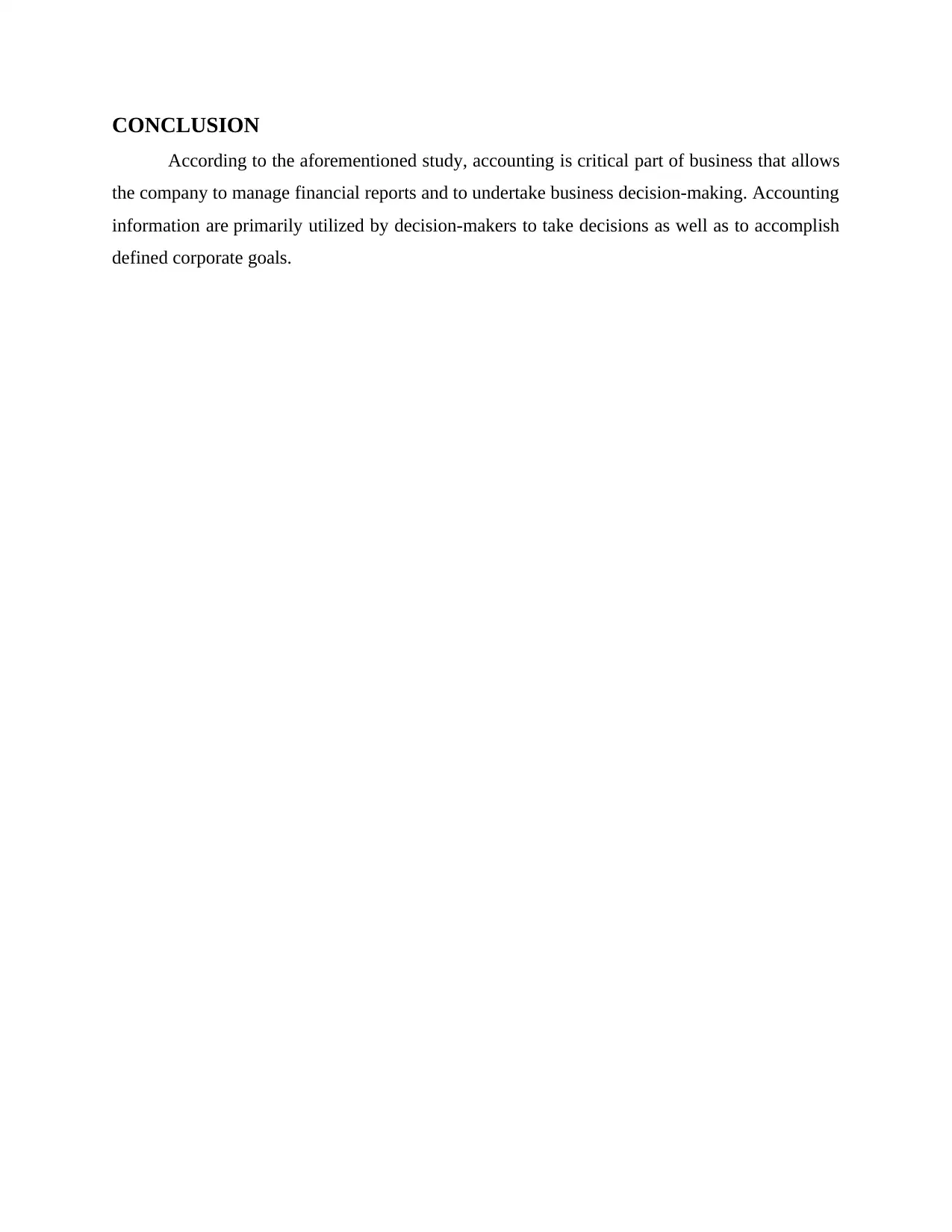
CONCLUSION
According to the aforementioned study, accounting is critical part of business that allows
the company to manage financial reports and to undertake business decision-making. Accounting
information are primarily utilized by decision-makers to take decisions as well as to accomplish
defined corporate goals.
According to the aforementioned study, accounting is critical part of business that allows
the company to manage financial reports and to undertake business decision-making. Accounting
information are primarily utilized by decision-makers to take decisions as well as to accomplish
defined corporate goals.
⊘ This is a preview!⊘
Do you want full access?
Subscribe today to unlock all pages.

Trusted by 1+ million students worldwide
1 out of 13
Related Documents
Your All-in-One AI-Powered Toolkit for Academic Success.
+13062052269
info@desklib.com
Available 24*7 on WhatsApp / Email
![[object Object]](/_next/static/media/star-bottom.7253800d.svg)
Unlock your academic potential
Copyright © 2020–2025 A2Z Services. All Rights Reserved. Developed and managed by ZUCOL.





